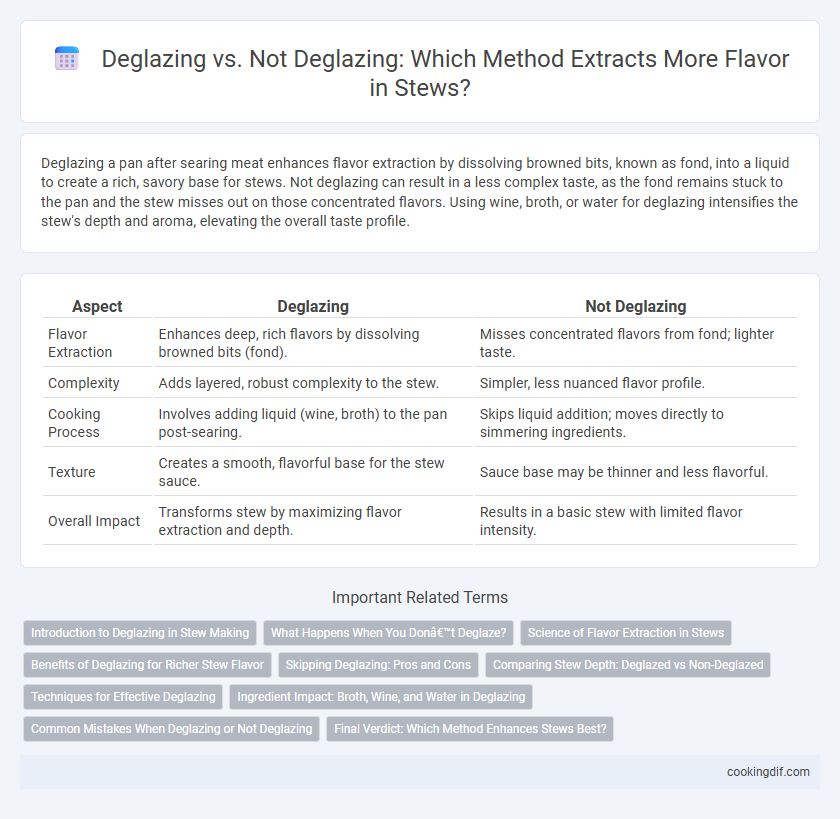Deglazing a pan after searing meat enhances flavor extraction by dissolving browned bits, known as fond, into a liquid to create a rich, savory base for stews. Not deglazing can result in a less complex taste, as the fond remains stuck to the pan and the stew misses out on those concentrated flavors. Using wine, broth, or water for deglazing intensifies the stew's depth and aroma, elevating the overall taste profile.
Table of Comparison
| Aspect | Deglazing | Not Deglazing |
|---|---|---|
| Flavor Extraction | Enhances deep, rich flavors by dissolving browned bits (fond). | Misses concentrated flavors from fond; lighter taste. |
| Complexity | Adds layered, robust complexity to the stew. | Simpler, less nuanced flavor profile. |
| Cooking Process | Involves adding liquid (wine, broth) to the pan post-searing. | Skips liquid addition; moves directly to simmering ingredients. |
| Texture | Creates a smooth, flavorful base for the stew sauce. | Sauce base may be thinner and less flavorful. |
| Overall Impact | Transforms stew by maximizing flavor extraction and depth. | Results in a basic stew with limited flavor intensity. |
Introduction to Deglazing in Stew Making
Deglazing is a crucial technique in stew making that involves adding liquid to a hot pan to dissolve browned food residue, known as fond, left after searing meat. This process intensifies the stew's flavor by incorporating the caramelized bits into the sauce, resulting in a richer and more complex taste profile. Skipping deglazing can lead to a less flavorful broth, as the depth contributed by fond remains trapped in the pan.
What Happens When You Don’t Deglaze?
Not deglazing after browning meat in a stew leaves flavorful brown bits, or fond, stuck to the pan, reducing the overall depth of flavor in the dish. Without deglazing, these flavorful compounds do not dissolve into the cooking liquid, resulting in a less rich and complex stew. This omission often leads to a flatter taste profile and missed opportunities for flavor development.
Science of Flavor Extraction in Stews
Deglazing enhances flavor extraction in stews by dissolving browned food residues containing Maillard reaction compounds, which are rich in savory and umami notes. The acidic liquid used in deglazing, such as wine or vinegar, breaks down caramelized proteins and sugars, intensifying the depth and complexity of the stew's flavor profile. Without deglazing, these savory compounds remain stuck to the pan, resulting in a less rich and layered taste.
Benefits of Deglazing for Richer Stew Flavor
Deglazing the pan after browning meat releases fond, the caramelized bits that hold intense flavor, enhancing the stew's depth and complexity. The process dissolves these savory residues with liquid such as wine, broth, or water, infusing the stew with concentrated taste and aroma. This technique results in a richer, more robust flavor profile compared to skipping deglazing, which can leave the stew less flavorful and flat.
Skipping Deglazing: Pros and Cons
Skipping deglazing in stew preparation preserves the initial caramelization, resulting in more robust and deeply seared meat flavors. However, omitting deglazing sacrifices the rich fond dissolved from the pan, potentially leading to a less complex and flatter broth. The decision hinges on desired flavor intensity and texture, as deglazing enhances depth, while skipping it maintains a purer, more straightforward taste profile.
Comparing Stew Depth: Deglazed vs Non-Deglazed
Deglazing a stew enhances flavor extraction by dissolving the caramelized fond from the pan, intensifying the stew's depth and complexity. Without deglazing, flavors remain more muted, as browned bits containing concentrated taste compounds are left behind. The resulting stew from deglazing offers a richer, more robust profile compared to the lighter, less developed flavors in a non-deglazed stew.
Techniques for Effective Deglazing
Deglazing enhances stew flavor by dissolving browned fond from the pan using liquids like wine, broth, or vinegar, concentrating savory notes and deepening complexity. Achieving effective deglazing requires maintaining medium heat to avoid burning the fond while stirring gently to lift all caramelized bits. Selecting the right deglazing liquid balances acidity and sweetness, optimizing extraction of flavorful compounds crucial for rich, layered stew profiles.
Ingredient Impact: Broth, Wine, and Water in Deglazing
Deglazing a stew with broth or wine significantly enhances flavor extraction by dissolving browned food particles, enriching the depth and complexity of the dish. Broth adds a savory, umami-rich base that intensifies meatiness, while wine introduces acidity and aromatic compounds that balance richness. Using water for deglazing extracts fewer flavor compounds, resulting in a less robust stew compared to broth or wine.
Common Mistakes When Deglazing or Not Deglazing
Failing to deglaze after browning meat in stew results in stuck-on bits that contain concentrated flavors, leading to a less rich and complex sauce. Common mistakes when deglazing include using cold liquid that shocks the pan, not scraping the fond thoroughly, or pouring in too much liquid, which dilutes the flavor. Skipping the deglazing step often causes the stew to taste flat, missing the deep, caramelized notes essential for a robust profile.
Final Verdict: Which Method Enhances Stews Best?
Deglazing enhances stews by lifting browned fond from the pan, infusing the dish with rich, concentrated flavors that deepen the overall taste profile. Skipping deglazing results in a milder stew, as the caramelized bits remain stuck, reducing the intensity and complexity of the flavor. For optimal flavor extraction and a robust, savory stew, deglazing is the preferred method.
Deglazing vs not deglazing for flavor extraction Infographic

 cookingdif.com
cookingdif.com